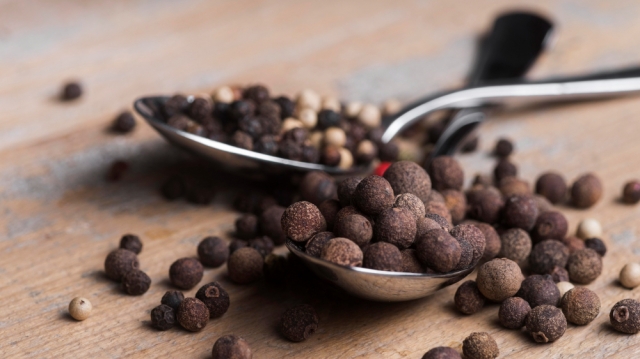Often hailed as the "king of spices," peppercorns have been a crucial ingredient in kitchens across the globe for centuries. Their ability to enhance and transform dishes makes them a must-have in any culinary arsenal. Discover how incorporating peppercorns into your cooking can turn ordinary meals into extraordinary experiences.
Peppercorns: The Flavorful Cornerstone
Peppercorns come in several varieties, each offering distinct flavors. Black peppercorns are the most common, known for their intense, robust heat that adds depth and warmth to a dish. White peppercorns, which are black peppercorns with the outer layer removed, deliver a milder, earthier spice. Green peppercorns, picked before they ripen, impart a fresh, slightly fruity taste. Though technically not true, pink peppercorns add a sweet, peppery nuance to dishes.
Elevating Meat Dishes
Peppercorns can significantly enhance meat dishes by adding a layer of sophistication. Freshly cracked black pepper provides a bold kick that enhances savory flavors for steaks, roasts, or grilled meats. Coating meat with crushed peppercorns before cooking creates a flavorful crust that adds both texture and taste. For lighter meats like chicken or fish, white peppercorns are perfect for a subtle heat that doesn't overpower the delicate flavors.
When it comes to red meats, particularly beef, black peppercorns shine. For instance, a classic steak au poivre relies heavily on the intense heat and aroma of black peppercorns. The process typically involves pressing crushed peppercorns into the steak before searing it, creating a flavorful crust that is further enhanced by a creamy, cognac-infused sauce. This dish exemplifies how black peppercorns can elevate the dining experience by adding complexity and depth to the meat's flavor.
For poultry, white peppercorns are often preferred due to their subtlety. For example, a delicate chicken velouté sauce benefits from the gentle heat of white peppercorns, which enhance without overpowering the creamy base. Similarly, white peppercorns can be used in poaching liquids for fish, providing a nuanced flavor that complements rather than dominates the dish.
Boosting Vegetable Dishes
Peppercorns can work wonders with vegetables, bringing out their natural sweetness and adding a touch of heat. Whether roasting, sautéing, or steaming, a generous sprinkle of freshly ground black pepper can elevate the flavor of vegetables. Peppercorns are particularly effective with root vegetables such as carrots and potatoes, as well as with leafy greens like spinach and kale. For an extra burst of flavor, try adding a pinch of crushed green peppercorns.
Roasted root vegetables with a black peppercorn and herb crust offer a simple yet delicious way to incorporate this spice. The heat from the peppercorns pairs beautifully with the caramelized sweetness of vegetables like carrots, parsnips, and sweet potatoes. Additionally, a sauté of leafy greens such as spinach or kale can be transformed with the addition of green peppercorns, which provide a fresh and slightly tangy contrast.
Seasoning Soups and Sauces
A dash of black pepper can enhance the flavor of hearty soups or stews, providing a sharp contrast to rich, creamy textures. White peppercorns offer a more delicate heat for sauces without leaving visible specks. Mix black and green peppercorns in your sauces to create a complex flavor profile for added depth and sophistication.
Classic French cuisine often showcases the use of white peppercorns in creamy soups and sauces. For example, a velvety potato leek soup benefits from the subtle heat of white peppercorns, which add complexity without altering the soup's pale color. On the other hand, black peppercorns are ideal for robust soups like beef stew or minestrone, where their pronounced heat and aroma can stand up to the hearty ingredients.
Transforming Salads and Dressings
Peppercorns can also bring new life to salads and dressings. Freshly ground black pepper adds a punch to vinaigrettes and marinades, while pink peppercorns introduce a hint of sweetness and vibrant color. For a unique touch, try infusing olive oil with whole peppercorns. This peppercorn-infused oil can be drizzled over salads or used as a finishing touch for a variety of dishes.
A simple green salad can be elevated with a vinaigrette that features crushed black and pink peppercorns. The black pepper provides a spicy kick, while the pink peppercorns add a subtle sweetness and a visually appealing touch. Moreover, creating a peppercorn-infused olive oil involves gently heating the oil with whole peppercorns, allowing the flavors to meld. This infused oil can be used not only for salads but also as a drizzle for grilled vegetables or even a dip for fresh bread.
Creating Custom Spice Blends
Peppercorns serve as an excellent base for crafting your own spice blends. Combine crushed black peppercorns with herbs like thyme or rosemary, and spices like paprika or cumin, to develop a blend that suits your taste preferences. This custom mix can be used to season meats, vegetables, soups, and stews, offering a personalized touch to your cooking.
A homemade steak rub might include black peppercorns, smoked paprika, garlic powder, and dried thyme. This combination creates a robust flavor profile that enhances the meat's natural flavors. For a Mediterranean-inspired blend, you could mix black peppercorns with dried oregano, basil, and fennel seeds. This versatile blend can be sprinkled on roasted vegetables, mixed into marinades, or used to season grilled fish.
Exploring Sweet and Savory Combinations
Peppercorns aren't limited to savory dishes. They can also add a surprising complexity to sweet treats. Crushed black peppercorns can enhance fruit-based desserts or chocolate dishes by providing a contrasting heat that complements sweetness. This interplay of flavors creates a sophisticated balance that can elevate your dessert offerings.
One intriguing combination is dark chocolate with black pepper. The warmth and spice of the peppercorns enhance the deep, rich flavors of the chocolate, creating a sophisticated treat. Additionally, a fruit salad featuring strawberries, mangoes, and a light sprinkle of pink peppercorns can provide an unexpected yet delightful burst of flavor. The pink peppercorns add a sweet, peppery note that complements the fruit's natural sweetness.
Peppercorns in Global Cuisines
The versatility of peppercorns extends across various global cuisines, each utilizing the spice to create unique and flavorful dishes. In Indian cuisine, for example, black peppercorns are a key ingredient in garam masala, a spice blend that adds depth to curries, lentils, and meat dishes. In Chinese cuisine, Sichuan peppercorns, which are not true peppercorns but share a similar name, are essential for creating the signature numbing and spicy flavor of Sichuan dishes.
In Italian cuisine, peppercorns are integral to the classic Roman pasta dish, Cacio e Pepe. This simple yet delicious recipe relies on freshly ground black pepper and Pecorino Romano cheese to create a creamy, peppery sauce that coats each strand of pasta. Similarly, in French cuisine, the use of black and white peppercorns is prevalent in various sauces and seasonings, showcasing their ability to enhance and balance flavors.
The Health Benefits of Peppercorns
Beyond their culinary uses, peppercorns offer several health benefits. Black peppercorns, for instance, contain piperine, a compound known for its antioxidant and anti-inflammatory properties. Piperine can enhance the bioavailability of certain nutrients, making it easier for the body to absorb them. Additionally, peppercorns have been used in traditional medicine to aid digestion and improve gut health.
Green peppercorns, often used in pickling and sauces, contain a variety of vitamins and minerals, including vitamin C, K, and iron. These nutrients contribute to overall health and well-being, providing additional reasons to incorporate peppercorns into your diet. The anti-microbial properties of peppercorns also make them beneficial for preserving food, ensuring that dishes remain fresh and safe to eat for longer periods.
Sustainable Sourcing and Quality
When incorporating peppercorns into your cooking, it's essential to consider the quality and sourcing of the spice. Opting for high-quality, sustainably sourced peppercorns ensures that you are not only getting the best flavor but also supporting ethical and environmentally friendly practices. Many specialty spice shops and online retailers offer a variety of peppercorns, allowing you to explore different flavors and origins.
By choosing whole peppercorns and grinding them fresh as needed, you can maximize the flavor and aroma, ensuring that each dish benefits from the spice's full potential. Additionally, storing peppercorns in a cool, dry place away from direct sunlight will help maintain their freshness and potency over time.
Conclusion
Peppercorns are a versatile ingredient that can transform a wide range of dishes. Whether enhancing meats, vegetables, soups, or even sweets, peppercorns add depth, heat, and complexity to your culinary creations. By experimenting with different varieties and methods, you can discover new ways to elevate your cooking and enjoy the rich, multifaceted flavors that peppercorns bring to the table. Embrace the king of spices and unleash its full potential in your kitchen, turning every meal into an extraordinary experience.






